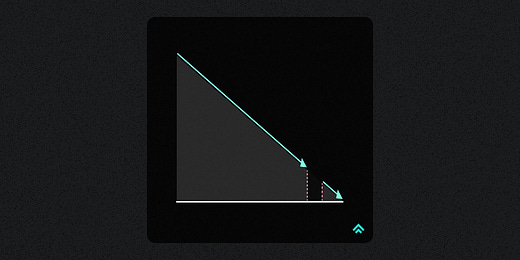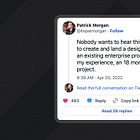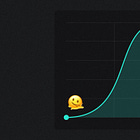The Design Execution Gap
Why it's hard to stick the landing with design execution and what we might do about it.
Hello! I’m Pat and Better by Design is my newsletter devoted to helping you get a strategic edge in the next era of creative technology. If you’re new here, join our tribe of creative tech hybrids as we uncover new insights each week.
Here’s a catch-22:
Developers don’t want to own the UI design because they’d rather focus on programming but designers can’t own the design implementation because it’s too tightly coupled to complex front-end logic.
It’s no wonder a lot of companies can’t execute their design vision when the people who want to own the design execution can’t, and the people who do own it, would rather not.
We’re stuck in what I call the “design execution gap”. A place where, despite everyone’s best intent, it’s hard to stick the landing in the last 10% of design execution.
So, where’s the gap coming from? And how might we address it?
Let’s take a look.
The lessening design gap
The gap used to live more on the design side.
Design tooling simply couldn’t deliver a close approximation of web UI. Web designers were working with inherited tools meant to create static images for print, so every design was just a picture developers had to interpret and build from scratch based on their eyes alone. It was impossible to work in a design “reality” that even came close to reflecting the reality of the code.
In 2014 when I started working at American Express we solved this problem by embedding UI developers into the product design team to enable us to prototype our designs in code (this was my role on that team). We’d then hand off that front-end prototype to the official dev team to integrate it into our broader production tech stack. Compared to handing off static screens in Adobe Illustrator or InDesign this approach better captured the team’s design intent and lessened the execution gap.
UI design tools have come a long way since that time. They’ve not only gotten generally better, but they’ve focused specifically on designing for the web. First, it was integrating Sketch for UI design and some rudimentary re-usable elements. Then we added on a basic interaction layer with tools like the Sketch + InVision combo (RIP InVision ☠️). Then finally we started putting the pieces together with tools like Figma, today’s dominant player.
Since adopting Figma I’ve been able to deliver designs that are much closer to the reality of the UI we intend to ship. It’s still not perfect, but between my efforts to align design structure with code structure and Figma’s dev mode functionality the developers I work with are now able to get a more descriptive picture of the UI they’re meant to build.
The lingering dev gap
The bulk of the gap now lives on the development side.
Compared with my Figma handoffs, there’s no good analog to help designers dig into the front-end code to ensure the design is being captured as intended. The front end of the web has gotten so much more complex and abstract over the last ten years that it’s less accessible for non-developers to contribute to the implementation of the design. The content, style, and interactivity layers are so tightly bound to other logic that it’s at least impractical, if not impossible, for someone to safely contribute without routinely working in the codebase.
Even a designer who is okay with opening the web inspector is stuck. Sure, I can inspect the elements, but since the CSS classes are often generated and scrambled these days, just looking at the markup tells me little about how the interface is composed. It also makes it difficult to work through minor tweaks exclusively in the browser because many of the styles of like-elements are no longer technically shared via the cascade.
This is a problem for the last 10% of design execution. If we were working together in person it would be somewhat less of an issue because I could just sit next to my dev partner to pair on dialing in the details. But in the context of a remote, distributed team it tends to feel like a burden to continually request more fine-tuning over Slack messages, Zoom invites, and GitHub comments. So I either end up feeling like a pain in the ass or I let a few minor details slide. Not a great situation either way.
So, in my opinion, we need to find a way to re-expose the stylistic portion of the front end to the people who both deeply care about it and have the skills to fine-tune it. But how?
A product isn’t the solution... yet
Perhaps your first instinct is to make another product to bridge this gap.
It’s not a bad idea, but I don’t think it’s the first step.
For websites (vs. apps) we do now have tools like Webflow and Framer which give designers more direct control over styling in a visual format that’s more accessible to them. This is a meaningful evolution, it just doesn’t meet my complex, web app use case yet.
At least for the apps that I work on, the front-end architecture is sufficiently complex and unique on a company-by-company basis that I think it would be a challenge to design a product that’s both generic enough to cover all the variation and specific enough to add deep value to my existing workflow (not to mention warrant the expense on my team’s budget).
I’ve tried a number of tools over the years that have attempted to smooth out this middle ground between design and development but have never stuck with them. Why? Because sitting in the middle is awkward. It meant that the tools didn’t fully meet the needs of either designers or developers. They were just kinda okay, and “kinda okay” isn’t good enough to merit the overhead of adding one more tool into the telephone game of communicating design intent.
A potential first step
My instinct is that our first step is not to try to solve this with a product, but rather with a cultural and architectural shift on the front end to begin intentionally crafting a way to make the stylistic portion of the web more approachable for designers. Then, if we can expose that portion of our apps in a standardized way, that would provide a better foundation for a product to come in and elevate that basic interface to another level of polished approachability.
Final thoughts
To conclude, I want to pose a challenge to both designers and developers to help us move forward together:
As a designer, how might I level up my technical skills to share more ownership of the last 10% of design execution?
As a developer, how might I architect a more approachable and inclusive way to craft and maintain application styling?
Have ideas on how we might bridge this gap? Leave a comment!
Need guidance on navigating this problem in your work? Message me and let’s talk. I’m happy to talk through your situation and support you how I can.
Until next time,
Pat 💚
If you got a little value in this post, consider subscribing, sharing, or following me on Twitter. If you got a lot of value I’d appreciate it if you bought me a coffee 😎☕️.







